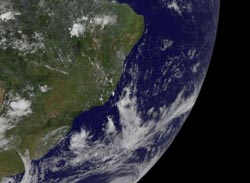90Q: A curious short-lived 'tropical' cyclone in the southern Atlantic

The GOES-12 satellite captured this visible image of System 90Q at 14:45 UTC (9:45 a.m. ET) on March 10, 2010. 90Q is the small circular area of clouds (lower left center). Credit: NASA GOES Project<br>
On Wednesday, March 10 at 1400 UTC (9:00 a.m. ET) “System 90Q” was located near 29.8 degrees South latitude and 48.2 degrees West longitude, about 180 miles east of Puerto Alegre, Brazil.
The Naval Research Laboratory said on March 10 the system had maximum sustained winds near 39 mph (35 knots) but has weakened today below the tropical storm-force winds threshold.
The Geostationary Operational Environmental Satellite, GOES-12 captured a visible image of System 90Q at 14:45 UTC (9:45 a.m. ET) on March 11, and it appeared as a small circular area of clouds off the Brazilian coast. GOES is operated by the National Oceanic and Atmospheric Administration, and NASA's GOES Project, located at NASA's Goddard Space Flight Center, Greenbelt, Md. creates some of the GOES satellite images.
System 90Q continues to move away from the Brazilian coast and is expected to be absorbed in a mid-latitude cold front in the next couple of days.
Media Contact
More Information:
http://www.nasa.govAll latest news from the category: Earth Sciences
Earth Sciences (also referred to as Geosciences), which deals with basic issues surrounding our planet, plays a vital role in the area of energy and raw materials supply.
Earth Sciences comprises subjects such as geology, geography, geological informatics, paleontology, mineralogy, petrography, crystallography, geophysics, geodesy, glaciology, cartography, photogrammetry, meteorology and seismology, early-warning systems, earthquake research and polar research.
Newest articles

Properties of new materials for microchips
… can now be measured well. Reseachers of Delft University of Technology demonstrated measuring performance properties of ultrathin silicon membranes. Making ever smaller and more powerful chips requires new ultrathin…

Floating solar’s potential
… to support sustainable development by addressing climate, water, and energy goals holistically. A new study published this week in Nature Energy raises the potential for floating solar photovoltaics (FPV)…

Skyrmions move at record speeds
… a step towards the computing of the future. An international research team led by scientists from the CNRS1 has discovered that the magnetic nanobubbles2 known as skyrmions can be…




















